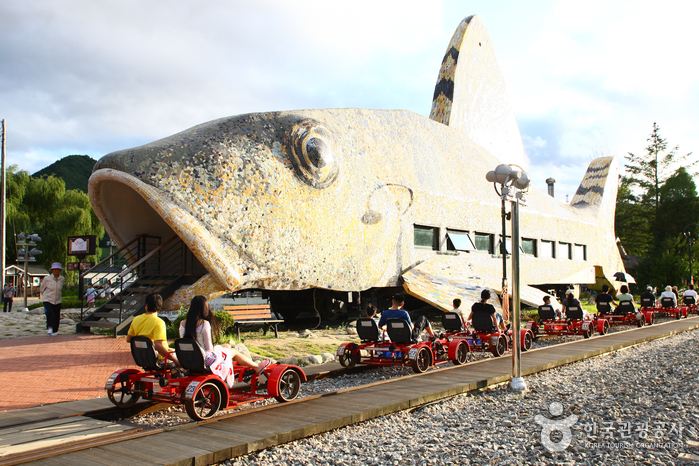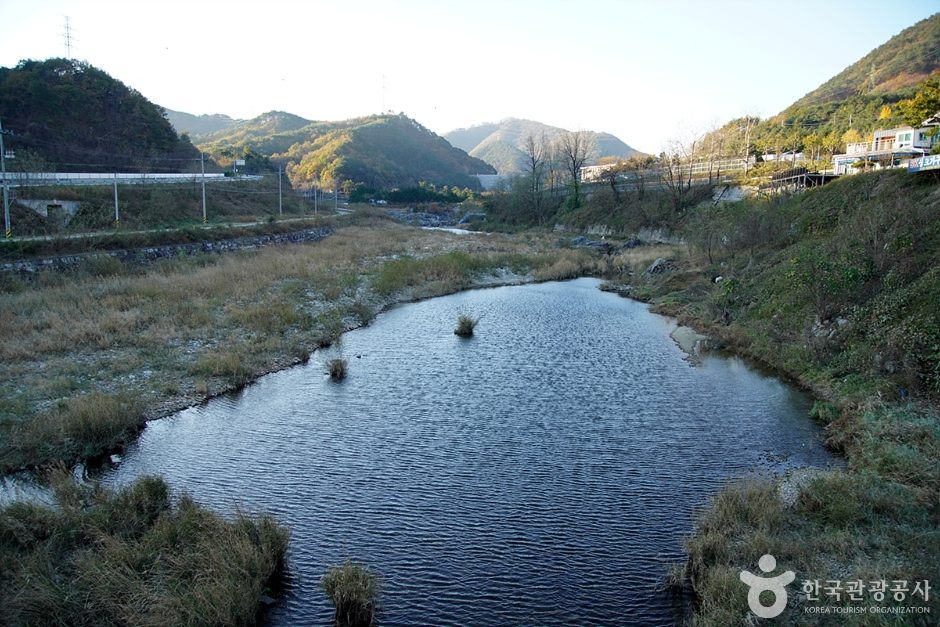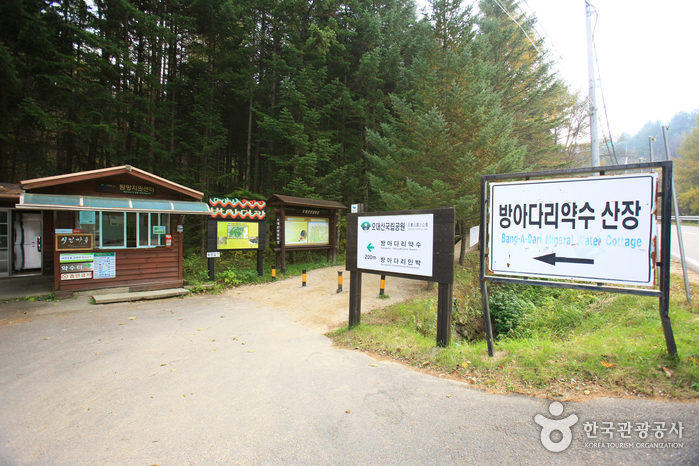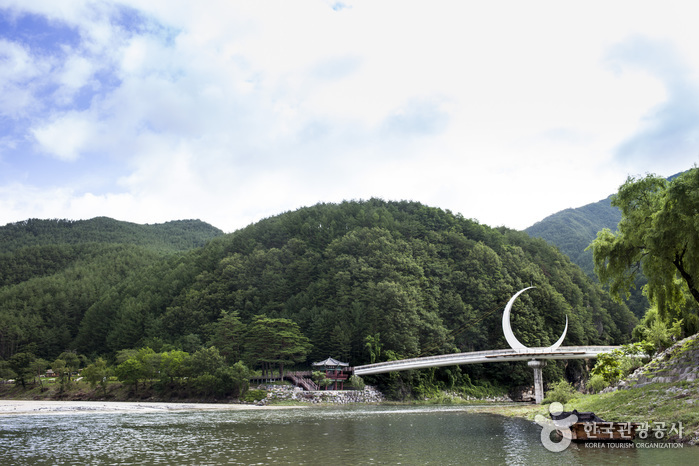Jeongseon Railbike (정선레일바이크)
14.5Km 2022-12-23
745, Nochusan-ro, Jeongseon-gun, Gangwon-do
+82-33-563-8787
Jeongseon Railbike was the first railbike location to open in Korea. Offering both two- and four-person bikes, riders depart from Gujeol Station and travel 7.2 kilometers along an abandoned railway track to Auraji Station. The tracks pass along the clean river, through a forest, and through old train tunnels decorated with vibrant lights.
The track of Jeongseon Railbike is relatively flat, making it easy for all riders to enjoy the passing scenery in comfort. The full track takes about 30~40 minutes to complete. After arriving, visitors can hop aboard the train that takes riders back to Gujeol Station. There are cafes at Gujeol and Auraji Stations designed to look like a grasshopper and a fish, respectively. These train cafes make for great photos! The Ant Pension also is fun, designed just like an ant.
Namdaecheon Stream (남대천(강릉))
15.0Km 2025-10-23
Gusanan-gil, Seongsan-myeon, Gangneung-si, Gangwon Special Self-Governing Province
Namdaecheon Stream in Gangneung, the actual location where the character Seong-jun warned Su-hyuk in the movie "A Man of Reason," is a river that flows through Gangneung and enters the East Sea. Near the downstream area, you can also enjoy the natural scenery and reed forests of Namdaecheon at the Ecological Observation Center.
Bangadari Mineral Spring (방아다리약수터)
17.0Km 2023-04-07
1011-26, Bangadari-ro, Pyeongchang-gun, Gangwon-do
+82-33-336-3145
Bangadari Mineral Spring is a crisp and healthy water source located in the woods off the Yeongdong Highway. The mineral spring contains over 30 kinds of healthy minerals including carbonic acid and iron, which are known to be especially effective in treating stomach disorders, anemia, and neuralgia. The 1-kilometer long path leading from the entrance to the mineral spring site is great for taking a stroll as it is surrounded by fir trees.
Gangneung Solhyang Arboretum (강릉 솔향수목원)
17.0Km 2023-12-06
156 Sumogwon-gil, Gujeong-myeon, Gangneung-si, Gangwon-do
Gangneung Solhyang Arboretum was built in 2008 and opened on October 30, 2013 in Gujeong-ri, Gujeong-myeon. The arboretum was formed around the scenic Yongsogol Valley and the foothills of Chilseongsan Mountain, which still preserves the prestigious Geumgang pine tree forest. The arboretum spreads across an area of 78.5 ha and is organized in 25 themes that boast a total of 220,000 plants of 1,127 different species. Visitors can enjoy a wide variety of scenery that change with season as well as themed areas such as eco-forest path dense with a colony of ginger trees and bamboos, pine forest square, wildflower gardens and more. The main attraction of this arboretum is the walking path named "Breath of Thousand Years Healing Path."
Auraji Lake (아우라지)
18.8Km 2022-12-26
69, Auraji-gil, Jeongseon-gun, Gangwon-do
+82-1544-9053
Auraji is the name of a lake located in Yeoryang-myeon in Jeongseon-gun. It is here that Jeongseon Arirang, the Intangible Cultural Asset of Gangwon-do, originated. The area has long been famous for its beautiful, clean mountains and rivers. Its name is derived from the Korean word eoureojida, meaning "to meet" as the waters of Pyeongchang and Samcheok unite in this area.
Part of the upper stream of Namhangang River, Auraji was a famous starting point of log rafts transporting timber to Hanyang, the original name of Seoul. In the old days, one could always hear the singing of boatmen who came from all over the nation. The lyrics of Jeongseon Arirang reveal the sadness and longing of a woman awaiting her husband who left for business to a far-away place or left to transport timber.
Jeongseon Arirang Training Hall (정선아리랑 전수관)
18.9Km 2021-07-21
69, Auraji-gil, Jeongseon-gun, Gangwon-do
+82-33-560-2897
Jeongseon Arirang is an important intangible heritage of Korea, being designated Gangwon-do Intangible Cultural Asset No. 1, as well as recorded as a UNESCO Intangible Cultural Heriatge. The song was created in the late Goryeo dynasty by seven worshippers of the dynasty who settled in Jeongseon. The song was made to help the local scholars understand Chinese poetry, and to express the stories and emotions to the locals. The Jeongseon Arirang Training Hall was established to preserve and promote this history, as well as develop the local folk culture. The hall is located by the Auraji riverside at the point where Songcheon and Goljicheon Streams meet. The facilities are comprised of three buildings, divided into an exhibition area, and a experience area. In the experience area, visitors can learn how to perform Jeongseon Arirang by official holders of the intangible heritage. Programs are free but require advance reservation.
Sangwonsa Temple (상원사(오대산))
19.2Km 2021-12-06
1215-89, Odaesan-ro, Pyeongchang-gun, Gangwon-do
+82-33-332-6666
Sangwonsa Temple is located 8 kilometers north of Woljeongsa Temple. The temple was built by Buddhist monk Ja Jang in the 12th year of Silla Queen Seondeok, and rebuilt in 705 during the 4th year of King Seongdeok's reign. It burned down in 1946, but was restored once again in 1947. The temple is home to the Bronze Bell of Sangwonsa (a National Treasure), the oldest bronze bell in the nation. The bell, built during the 24th year of King Seongdeok, has a x_height of 1.67 meters and a diameter of 91 centimeters with a beautiful, clear ring. Other relics at the temple include Statue of Child Manjusri, said to have been seen directly by King Sejo, as well as a tablet commending the rebuilding of Sangwonsa Temple, written by King Sejo. Gwangdaegeori, located at the temple entrance, is also connected with King Sejo through a story of his bathing in the pure mountain stream one day while visiting Sangwonsa Temple.
Sugamgyegok Valley (숙암계곡)
19.3Km 2024-02-28
Danim-gil, Bukpyeong-myeon, Jeongseon-gun, Gangwon-do
Sugamgyegok Valley, stretching 10 kilometers long, meanders around Sangwonsan and Gariwangsan Mountains. The roads flanking the valley are favored destinations for scenic drives. One of the valley's key features is the Sugamsaem Spring, known for its clear and cold water. Upstream, a 20-meter-tall waterfall stands as a prime attraction, complemented by the historical Sugamseowon Confucian Academy. The valley is lush and verdant in spring, transforming into a vibrant display of red fall colors in autumn. Visitors can follow the hiking trails to fully immerse themselves in the stunning scenery of the valley.
Terarosa Coffee (테라로사 커피공장)
19.5Km 2024-02-28
7 Hyeoncheon-gil, Gujeong-myeon, Gangneung-si, Gangwon-do
+82-33-648-2760
Terarosa Coffee is a sprawling coffee shop and roastery that encompasses a coffee factory, café, restaurant, bakery, art shop, coffee museum, and garden. Its signature offering is a wide array of drip coffees. In addition to these, Terarosa also serves various other beverages and desserts. The bakery section offers baked goods and cookies that pair excellently with coffee. The premises are also well-known for their stunning natural surroundings, red-bricked buildings, and chic industrial interior.
Park Roche Resort & Wellness (파크로쉬 리조트앤웰니스)
19.7Km 2025-10-23
9-12 Jungbong-gil, Bukpyeong-myeon, Jeongseon-gun, Gangwon-do
+82-33-560-1111
Park Roche Resort & Wellness, run by Resort HDC, is a top-notch wellness resort in Korea. Its location boasts the clean and beautiful nature of Gangwon-do with its mountain, valleys, and waterfalls. The resort operates premium wellness programs, including expert-guided wellness programs, healthy gourmet dishes made with local ingredients, and unique healing programs amidst pristine nature.
The resort won first place in the T+L Luxury Awards Asia Pacific 2023 hosted by the globally renowned travel magazine Travel+Leisure; and was chosen as a recommended wellness tourist destination by the Korea Tourism Organization and the Ministry of Culture, Sports and Tourism. It is a true companion that carefully guides you so that you can experience the best wellness journey.








 English
English
 한국어
한국어 日本語
日本語 中文(简体)
中文(简体) Deutsch
Deutsch Français
Français Español
Español Русский
Русский